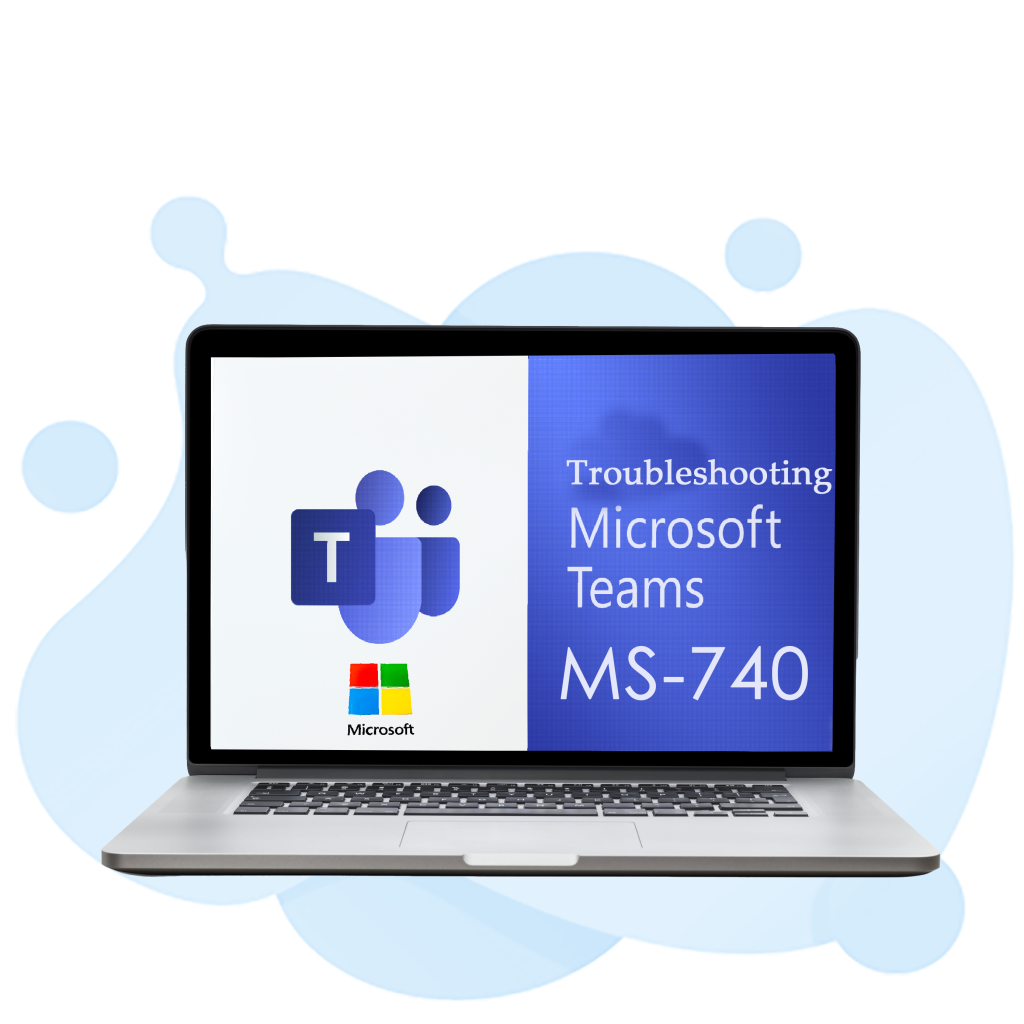MS 740 Exam

Troubleshooting Microsoft Teams MS-740 is an advanced technical exam that covers troubleshooting issues in meetings, live events, and messaging. It also includes federation issues, signing in, and teams and channels. Passing this exam earns the Microsoft 365 Certified: Teams Support Engineer Specialty Associate certification.
Candidates for this exam are support engineers who use advanced troubleshooting methods to support Microsoft Teams environments, troubleshoot deployments, and tune performance. They are expected to review logs and other data to infer the root cause of an issue and provide a solution.
Free Troubleshooting Microsoft Teams (MS-740) Practice Test Online
Microsoft Teams App Troubleshooting
Microsoft Teams is a powerful communication tool. Its popularity has increased during the Covid-19 pandemic, with people relying on it to stay connected and work from home. However, it’s not perfect and can experience problems from time to time. Fortunately, these issues are easy to resolve.
If you’re experiencing a problem with your Microsoft Teams app, the first thing to do is check that you’ve entered the correct login information. Then, check that your device’s date and time are set correctly. It’s also important to make sure that your network isn’t blocking access to the application.
If you’re having trouble with your camera or microphone, you may need to give Microsoft Teams permission to use them. This can be done in the Permissions window. The steps to do this vary depending on your operating system. For example, on Windows, you can right-click the Teams icon and select “Quit.” On Mac, you can press the Option, Command, and Escape keys at the same time to force-quit the application. After that, restart the program and try again.
Microsoft Teams Bad Network Quality Troubleshooting
Microsoft Teams is a great communication platform, but like any other application it has its shortcomings. One common problem is receiving the “Bad network quality” notification, which leads to lagging audio and video in meetings. Fortunately, there are several ways to fix the issue. First, make sure you’re using the latest version of Microsoft Teams. This is a simple step that can improve call quality. Additionally, make sure you’re not running any other applications that could be consuming bandwidth or utilizing memory. Lastly, disable read receipts and GPU hardware acceleration to reduce the load on your system.
Many of the most common Microsoft Teams issues are caused by network problems between users and the media servers that stream video, screen sharing, and call audio. These issues can occur due to poor Internet, SD WAN, private line or VPN connectivity. In addition to these basic troubleshooting steps, network administrators and IT specialists should use monitoring tools that detect and analyze Microsoft Teams performance metrics. This way, they can isolate the cause of these problems and resolve them quickly.

Microsoft Teams Meeting Troubleshooting
Microsoft Teams is a powerful unified communications tool that can be used for many purposes. Unfortunately, like any software, it can experience issues from time to time. These problems can range from a slow load time to audio/video quality issues during calls. Luckily, there are some troubleshooting tips that you can follow to resolve these issues quickly.
The first thing you should do is try restarting your computer. This can sometimes help with Microsoft Teams problems. If the problem persists, you should also check if there are any conflicting programs that could be causing the issue. For example, an outdated security program may be blocking Microsoft Teams from accessing the network.
Another way to troubleshoot is by using a free network monitoring tool like PingPlotter. This tool can help you determine if the problem is caused by your router, an internet service provider, or Microsoft Teams itself. Once you’ve determined the cause of the problem, you can fix it accordingly. If the problem isn’t fixed, you should then contact your IT administrator for further assistance.
Microsoft Teams Troubleshooting Audio
Microsoft Teams has been growing rapidly during the COVID-19 pandemic, but it has also seen a spike in complaints of various issues. Fortunately, many of these problems are easy to fix. If you have a microphone or speaker that isn’t working, try restarting your computer and checking if it’s still plugged in. If it’s not, unplug and reconnect it. You can also try a different USB port and cable. If you still can’t get the device to work, use a service like Downdetector to see if others have had similar issues.

Make sure you have the latest updates on your Windows or Mac machine. Occasionally, software incompatibilities can cause audio issues. Also, make sure you haven’t muted yourself in the app or during a meeting.
You can check for updates by clicking the three dots in the top-right corner and selecting “Check for updates”. If you haven’t updated your drivers recently, do so now. This will help ensure that Teams have access to your audio hardware. You can also adjust the microphone settings within the app to boost your audio output.
Microsoft Teams Troubleshooting Guide
If you’re having trouble logging into Microsoft Teams, there are some simple troubleshooting steps you can try. First, make sure that you have the correct login credentials. If you don’t, contact your IT department for assistance. Additionally, you can try restarting your computer and the application.
If the issue persists, you can also try using a service like Downdetector. This will help you find out if there are any known issues that affect the availability of Microsoft Teams. If you are unable to get the app to load, it may be a network issue. You can check the status of Microsoft Teams by visiting its official website and Twitter account.
Another common problem is a failure to create new Teams groups or teams. This can be due to a policy on the part of your company or organization. If this is the case, you should contact your IT department to see what can be done about it. Additionally, you should also ensure that you have the correct permissions to use the app.

Microsoft Teams Troubleshooting Tool
There are several reasons why Microsoft Teams may not be working correctly. These issues include high resource usage, poor quality audio and video, and connectivity problems. Some of these issues are due to outdated hardware or software, while others are due to a slow internet connection. If the problem persists, contact your IT department for assistance.
Another common issue is the inability to share your desktop screen during meetings. To resolve this, you can try the following steps: First, make sure that your computer has the latest updates. This will help to ensure that the Teams app is using all available resources and that your screen is not being blocked by other programs.
You can also check the network performance of Teams by deploying a monitoring agent to the user’s workstation. This will help you understand if the performance issue is caused by network latency or bandwidth capacity. In addition, a tool like Obkio can automatically launch PingPlotter to trace the Office 365 server used for Teams and show you the results in an easy-to-understand diagram.
Microsoft Teams Troubleshooting Video
The Microsoft Teams app can be a great tool for collaboration, but sometimes it may run into issues. These issues can range from connectivity problems to poor video quality. The good news is that these issues are often simple to resolve. If you are experiencing these problems, start by ensuring that your computer is connected to the internet. It is also important to check that your webcam and microphone are plugged in.

If you still can’t connect to Microsoft Teams, try restarting the application. You can also try using a third-party service like Downdetector to see if there is a network issue in your area. If the problem persists, you should contact your IT department and ask them to troubleshoot the issue. If you are a network administrator or IT specialist, you can use more advanced troubleshooting methods to identify and resolve performance and connection issues in Microsoft Teams. These techniques include monitoring network metrics, optimizing network performance, and analyzing traceroutes. These tips are especially useful for Microsoft 365 Certified Support Engineers who can analyze telemetry and log data to identify issues.
Microsoft Teams Call Quality Troubleshooting
Microsoft Teams is a communication and collaboration platform that can help users stay connected and productive. But, sometimes it can experience performance issues that affect call quality and meetings. These problems can be caused by a crowded network, device limitations, or even software bugs.
Fortunately, there are several steps you can take to troubleshoot these problems. First, ensure that you have a stable Internet connection. You can use an online speed test tool to check your Internet speed and latency. Another step is to close and restart Teams. This can often resolve temporary issues, and it’s worth trying before moving on to more advanced troubleshooting steps.
Next, if you’re still experiencing performance issues, you can try using a Network Monitoring tool like Obkio to identify and diagnose problems. This tool continuously monitors end-to-end Microsoft Teams performance and can diagnose network issues for you. Get started with Obkio’s free trial today!
Troubleshooting Microsoft Teams (MS-740) Questions and Answers
Microsoft Teams may be continuously opening due to several reasons. It could be due to a system glitch or a misconfiguration in your settings, causing the application to start automatically upon system startup or when certain events occur. Alternatively, there might be background processes or notifications triggering the app’s launch, leading to the repetitive opening behavior.
To close Microsoft Teams, you can follow a few simple steps. First, locate the Teams icon in your system tray or taskbar, which is typically found in the bottom-right corner of your screen. Right-click on the icon and select “Quit” or “Exit” from the context menu. Alternatively, you can also close Teams by clicking on your profile picture within the Teams application, then selecting “Sign Out” or “Quit.” This will fully close the application and any background processes associated with it.
To refresh Microsoft Teams and update its content, you can simply click on your profile picture or initials in the top-right corner of the application. From the drop-down menu, select “Check for updates” to prompt Teams to look for any available updates and refresh its interface to the latest version.
Microsoft Teams might not be working due to a variety of reasons. It could be related to internet connectivity issues, server outages on Microsoft’s end, or problems with your device’s settings. Additionally, software conflicts, outdated application versions, or issues with system resources might also contribute to Microsoft Teams not functioning as expected.
To prevent Microsoft Teams from opening on startup, you can adjust the application’s settings. On Windows, right-click on the Teams icon in the system tray, choose “Settings,” and under the “General” section, disable the “Auto-start application” option. On macOS, click on “Teams” in the top menu, select “Preferences,” go to the “General” tab, and uncheck the “Auto-start application” option. This will ensure that Microsoft Teams no longer opens automatically when you start your computer.
To restart Microsoft Teams, first, ensure that the application is closed. On Windows, right-click on the Teams icon in the system tray and select “Quit.” On macOS, click on “Teams” in the top menu and choose “Quit Microsoft Teams.” Once closed, you can then reopen Microsoft Teams by searching for it in your applications or using its shortcut, which will initiate a fresh start of the application.
To test your video in Microsoft Teams, follow these steps. Within the Teams application, click on your profile picture at the top-right corner and choose “Settings.” Under the “Devices” section, you’ll find the option to “Camera.” Click on it to preview your video feed and ensure your camera is working correctly.
To enable sound in Microsoft Teams, start by checking your device’s audio settings. Ensure that your speakers or headphones are properly connected and not muted. Then, within the Teams application, click on your profile picture at the top-right corner, select “Settings,” go to the “Devices” section, and choose your preferred audio device for both the speaker and microphone settings.
To leave a Microsoft Team, follow these steps. Within the Teams application, find the team you want to leave in the left sidebar. Right-click on the team’s name, and from the context menu, select “Leave the team.” This action will remove you from the team and its associated channels, conversations, and files.
To log out of Microsoft Teams, click on your profile picture or initials at the top-right corner of the application. From the drop-down menu, select “Sign Out.” This will log you out of your Microsoft Teams account, and you will need to enter your credentials to log in again.
To sign out of Microsoft Teams, click on your profile picture or initials located in the top-right corner of the application window. From the menu that appears, select “Sign Out.” This action will log you out of your Teams account, requiring you to enter your credentials again to access the application.
Microsoft Teams might not be opening due to various factors. It could be caused by a software glitch, conflicting background processes, or issues with system resources. Additionally, outdated application versions, corrupted files, or connectivity problems could also prevent Microsoft Teams from launching properly.
The perception of Microsoft Teams as “bad” can vary based on individual experiences and expectations. Some users might find it challenging to navigate due to its complex interface, while others might experience occasional glitches or connectivity issues. However, Microsoft Teams also offers a wide range of collaboration features, integration capabilities, and regular updates that many find beneficial for effective communication and teamwork.
To troubleshoot and fix Microsoft Teams when it’s not working, start by checking your internet connection and ensuring that the Teams service isn’t experiencing any outages. If the issue persists, try restarting the application, updating to the latest version, or clearing its cache. If problems persist, you can consider reinstalling the application or reaching out to Microsoft’s support for further assistance.
To troubleshoot issues with Microsoft Teams, begin by verifying your internet connectivity and checking for any ongoing service disruptions on Microsoft’s end. If the problem persists, try restarting the application, updating it to the latest version, or clearing its cache. Additionally, you can test Teams on a different device, disable any conflicting plugins or extensions, and consult Microsoft’s official support resources for specific troubleshooting steps related to your issue.
To get Microsoft Teams on your computer, you can follow these steps. If you’re using Windows, visit the Microsoft Teams website or the Microsoft Store, search for “Microsoft Teams,” and click the “Get” or “Download” button to install the application. For macOS users, you can find Microsoft Teams on the App Store, search for the app, and click “Get” to download and install it on your computer.
Using Microsoft Teams on your laptop is straightforward. After installing the application, open it and sign in with your Microsoft account. You can then join or create teams, participate in chats, meetings, and video calls, share files, collaborate on documents, and access a range of collaboration tools all within the Microsoft Teams interface on your laptop.